A guide to New Zealand’s backyard birds
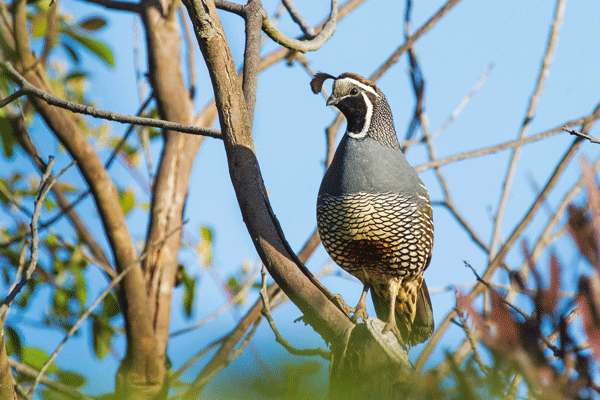
How to identify birds and encourage bird life in your backyard.
Words & images: Matt Winter
1. California quail
Identification: A small, plump, stocky, introduced game bird predominantly grey and brown, with a forward-curling black plume rising from the top of the head. The female’s crest plume is much smaller than the male’s. Males have a black chin and cheeks edged with white and separate white ‘eyebrows’ which join on the forehead. The breast is blue-grey and the lower belly cream to rust brown with distinctive black scalloping shapes. The female is slightly smaller, duller and browner with more subdued scalloping on the belly.
Distribution: Common over the whole of New Zealand but less frequent in Westland and coastal Southland. Found on the rough scrubby edges of rivers, inlets, forests, roads and rural gardens where good habitat include bracken, tussock grass, matagouri, gorse, blackberry, and lupins.
Breeding: Breeding season runs from September to February – nests are a flattened grassy area often placed against a log or rock. Eggs are beige with dark splotches and incubated by the female in 22 days. Eggs hatch at the same time, partly achieved by the chicks calling to each other while still in the egg. Bumblebee-sized striped chicks leave the nest as soon as they are dry, and are able to fly at just three weeks.
Diet: Consume seeds of many kinds, some fruit and leaves. Feed mainly early in the morning and late in the afternoon, spending more time foraging when food is scarce, eg winter. The young are initially fed insects.
Song: The call of the male california quail is distinctive. The calling bird is usually perched slightly above the surrounding area, on a post or branch, and has been described as sounding like ‘Chi-ca-go’, ‘Dick-Vercoe’ or ‘qua-quergo’.
Behaviour: In the autumn, family groups join up and stay together until late winter when the ‘covey’ (group of quail) breaks up into breeding pairs. Males can be very aggressive when courting and often fight each other. Courtship displays when attempting to woo a female include head dips, puffing up of contour feathers and spreading of the tail feathers.
How to encourage quail: These birds are exceptional at cleaning up spilled seed beneath bird feeders. However, quail are notoriously shy and it can be challenging to attract them to even the most bird-friendly property. You can make your block more ‘comforting’ to California quail by: sprinkling seeds near brush and shrubs or in a low broad ground feeder; having water baths/drippers on the ground; planting abundant, dense shrubs and thicket-like patches of vegetation where they can easily retreat to.
2. Fantail
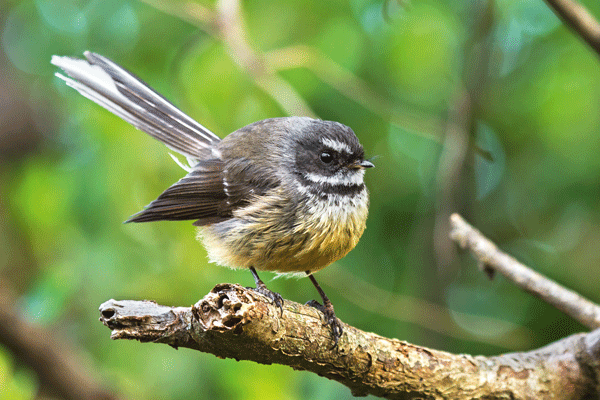
Identification: These wonderful little birds are most recognisable by their relatively large tail. They’re usually about 16cm long and weigh just 8g (2 tsp of sugar). Fantail have two colour phases; pied and black with pied are the most common. The pied has a greyish head, very obvious white eyebrows with a brown back and rump. Breast and belly are a cinnamon colour. Black variety is mostly black with a black-brown tinge over the rump, belly and flight feathers.
Distribution: Occur widely, from Northland to Stewart Island, and on some islands of the Chathams. Very habitat adaptable and able to live in extensive native forest blocks, small forest patches, scrubland, exotic plantations, farm shelterbelts, orchards and well-treed suburban parks and gardens. Altitudinal range extends from sea level to the snow line.
Breeding: Those at southern localities (eg, Southland) have shorter breeding seasons than those further north but will fall somewhere between August and February. Nest is constructed of fine materials tightly woven with cobwebs and include a tapered ‘tail’ of material below the base. 2-5 eggs are incubated by both parents, and both birds brood and feed the young through to fledging in just 14 days. One monitored pair reared five broods in a season, totalling 15 fledglings. Fantails stay in pairs all year.
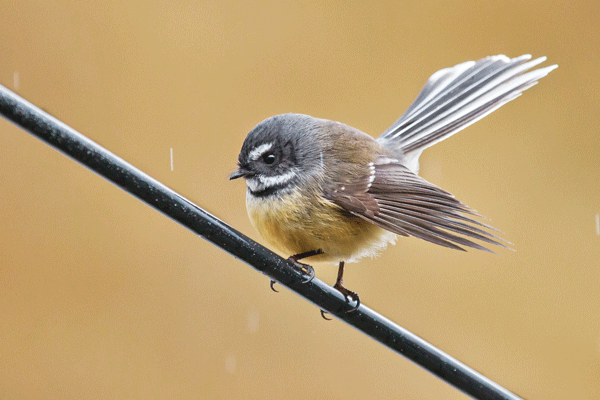
Diet: Fantails mainly eat small invertebrates, such as moths, flies, beetles and spiders. Large prey is subdued by being held in a foot against a perch and then being repeatedly pecked. Small fruit are occasionally eaten.
Behaviour: When you walk around your block, you may find you often have the pleasure of the company of a fantail or two. One of the three methods they employ to catch insects is by ‘association’; that is, they will follow another bird or animal to capture insects disturbed by their movements. The other two methods are ‘hawking’ (catching insects in flight) and ‘flushing’ (using their broad, fanned tail, flicking wings and rapid movements to disturb insects from denser vegetation). Given their small size, they are very susceptible to cold weather and severe winters result in high mortality rates.
How to encourage fantail: To get fantails into your garden you are going to need insects, so rather than the specific species of plants being the food source, think in terms of plants or trees that will provide good insect habitat and subsequently, a good fantail food supply. A good layer of mulch or leaf litter on the garden will also encourage insects.
A bird bath will be a huge magnet in dry weather as fantails are drawn irresistibly to the sound of water whether it be a garden sprinkler, a dripping tap or a babbling stream.
3. Bellbird
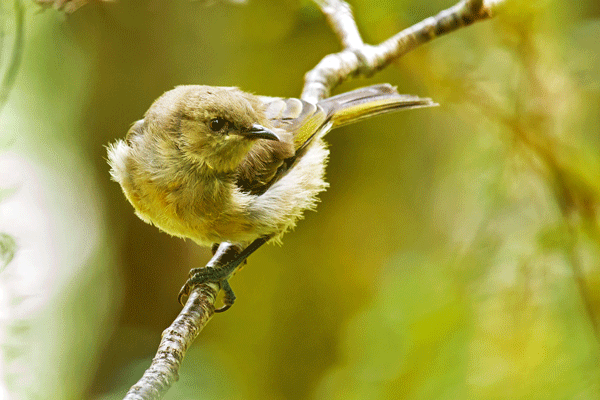
Identification: About 17-20cm long, weighing about 26g (females) to 34g (males). Males are olive green, slightly paler on the under parts, with a head tinted purple. Females are browner with a narrow white-yellow stripe across the cheek from the base of the bill and bluish gloss on top of the head. Most distinguishing feature are the wine-red eyes.
Distribution: Found in native and exotic forest, scrub, farm shelter belts, urban parks and gardens throughout the North, South and Stewart Islands. Almost completely absent on the mainland north of Hamilton, other than on Coromandel Peninsula.
Breeding: September to February. Nests are usually in the fork of a tree under dense cover, from near ground level up to 5m. Clutch size is typically 3-4 and a pair can raise two broods in a season; eggs are pale pink with reddish spots and blotches. Pairs return to the same breeding territory each year.
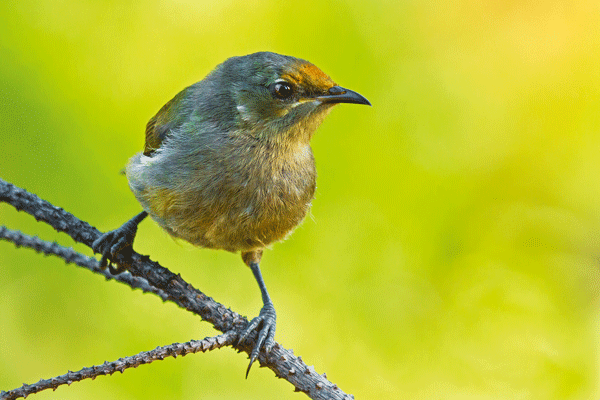
Diet: Feed mainly on nectar from many native and introduced plants, but in late summer and autumn they will eat fruit and berries. Will also eat many insects and spiders by gleaning (collecting off) trunks, branches and leaves. ‘Hawking’ (catching prey in flight) is another method. Young appear to be fed insects almost exclusively.
Behaviour: The bellbird is quite an aggressive bird both territorially and when it comes to defending a food source. I once witnessed a very severe aerial ‘beating’ of a long tailed cuckoo at the hand of a bellbird – the cuckoo didn’t stand a chance. Most Kiwis can easily recognise the bellbird by its melodious song which comprises three distinct sounds resembling the chiming of bells and these can have regional ‘dialects’ just as people from different parts of New Zealand can have noticeable regional accents. It’s sometimes confused with the sound of the tui but the bellbird ‘voice’ is more ‘pure’ in tone.
How to encourage bellbird: The bellbird loves nectar-rich plants: flax, kowhai, varieties of banksia, cabbage tree, bottlebrush, fuchsia. Sugar and water in a feeder will also attract bellbirds.
4. Tui
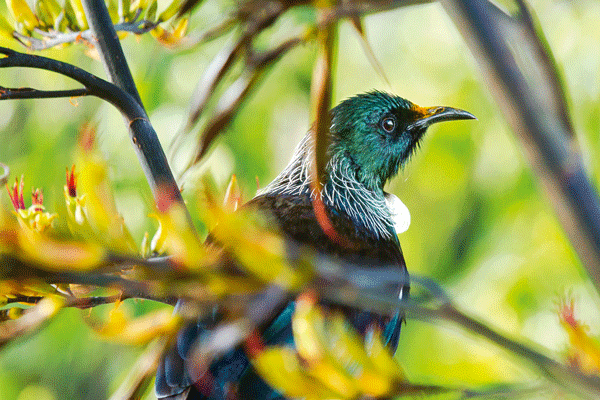
Identification: Endemic (occurs only in New Zealand), approximately 30cm long, 90g (female) to 120g (male). Plumage is a shining metallic green with bluish purple reflections on the shoulders and filamentous white feathers on the back and sides of the neck. Small white shoulder patches on the upper wing only show in flight. Two unusual curled white feather tufts on the throat.
Distribution: Abundant on the North, South and Stewart Islands, although scarce in the drier, more open country in the east of the South Island. Found in native forest and scrub (sometimes in exotic forests) and in rural gardens. Common in suburban parks and gardens with flowering trees and shrubs.
Breeding: September to February. Nest built by the female high in the canopy, laying 2-4 white eggs with dark ‘splotches’.
Diet: Preferred diet is nectar and honeydew from plants such as kowhai, fuchsia, rewarewa, flax, rata, pohutukawa and gums. In the breeding season, the diet is supplemented with large invertebrates such as cicadas and stick insects obtained by hawking (capturing while in flight) or by gleaning from the outside of trees.
Behaviour
I think the tui has the most melodious song of all native birds, perhaps rivalled only by the bellbird. Another wonderful feature is its display flights. This involves flying upwards, high above the bush and then making a noisy, speedy, near-vertical dive back into the canopy. Note: don’t do as Captain Cook did – it’s illegal!
How to encourage tui
Their top six favoured plants are kowhai, mountain flax, cabbage tree, mountain five-finger, ngaio and tree fuschia. Bird feeders are also a great way to provide a regular food source of sweetened water for tui which will keep coming back. A sugar/water ratio of 1:8 or 1:10 is ample – any stronger and you run the risk of attracting bees and wasps – and never use honey as it spoils quickly and can make birds ill. Keep the water clean by replacing it regularly.
1 simple trick to keeping birds safe
When planting your trees with the birds in mind, it is tempting to site them very near a window so you can enjoy the close observations that it will create. However, it is important to avoid planting too close to the house as reflections on windows can confuse birds. Kereru (wood pigeon) and other birds are killed every year trying to fly through panes of glass.
5. Thrush
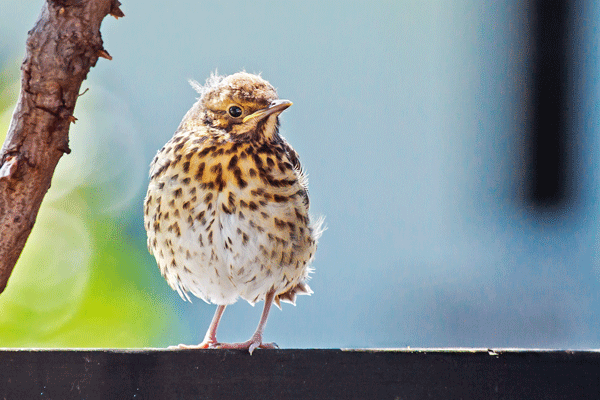
Identification: About 23cm and 70g, slightly smaller than a blackbird. The sexes are alike (monomorphic): head, back, upper wings and tail are a smooth grey-brown with indistinct streaking on the head. Males are distinguished from the similar-coloured female blackbird by pale cream under parts speckled with fawn-brown chevrons (V-shaped). Juveniles have similar colouring but the speckling on the breast is less distinct.
Distribution: Widespread throughout New Zealand from sea level up to about 800m altitude. Occur in urban areas, farmlands, orchards and in lowland indigenous forests. Usually seen as single birds or in pairs, are not known to flock.
Breeding: August to February producing 2-3 clutches of 3-4 eggs during a season. Incubation period is 12-13 days and done mostly by the female. Young are blind and naked when hatched and open their eyes after 5-6 days. Both sexes share feeding of the chicks and fledglings.
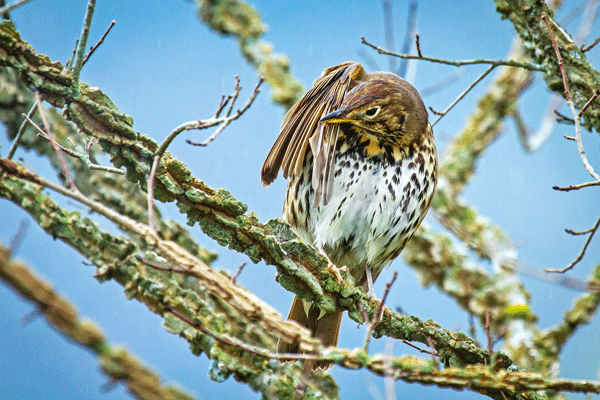
Diet: Feeds mainly on the ground, eating earthworms, various insects, spiders, snails and slugs found on lawns, under trees, hedges, forests or scrub. Also eat the small berries of some shrubs such as coprosma and can eat ripening fruit in orchards.
Behaviour: It is a real treat to observe thrush and blackbird on my current property. They have very similar habits, but the main difference I have noticed is that the thrush tends to be much more aware of what is going on and will be the first to duck for cover at any bold movement or noise. A thrush will stop with its head tilted on an angle ‘listening’ for food such as earthworms beneath the ground. They’ll also break the shells of snails by smashing the shell on a stone or path with a quick flick of the head.
How to encourage thrush: Thrushes eat a wide range of insects, worms and snails so a block of land with a lot of shrubs, trees and thick cover is far more appealing than a manicured lawn. Limited use of insecticides will also go a long way to maintaining some sort of insect population. Thrushes will love you even more if you let some of the fruit (or berries) stay on the tree until they ripen and drop off naturally.
6. Chaffinch
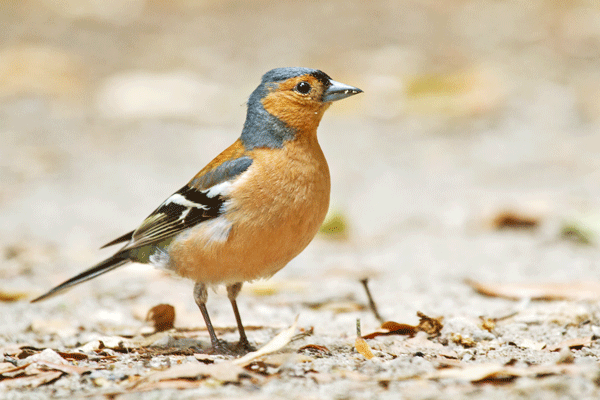
Identification: Males are similar in size to a house sparrow, with the females being a little smaller. Males are brightly coloured with brick-red breasts and chestnut mantles (back), greyish-blue crown and nape, wings black with a prominent white wing-bar and shoulder patch. Females are dull brownish-grey but with similar wing markings to the males.
Distribution: Widespread throughout the New Zealand mainland, Chatham Islands and Stewart Island. Occupy a wide range of habitats such as pine and other exotic forests, indigenous forests, sub-alpine scrub and are common in gardens, parks, orchards and farmland.
Breeding: September to February, when they will become quite territorial. 3-6 pale blue to greyish eggs with red and dark brown spots are incubated by the female alone but both parents feed the chicks.
Diet: Feed predominantly on seeds in winter, including tree seeds, and a variety of other seeds taken from on or near the ground, eg cereals, fat hen, chickweed, dandelion. Chicks are fed almost entirely on invertebrates (eg flies, beetles, moths, caterpillars, aphids and spiders) and a large proportion of the adult diet also consists of invertebrates during the breeding season.
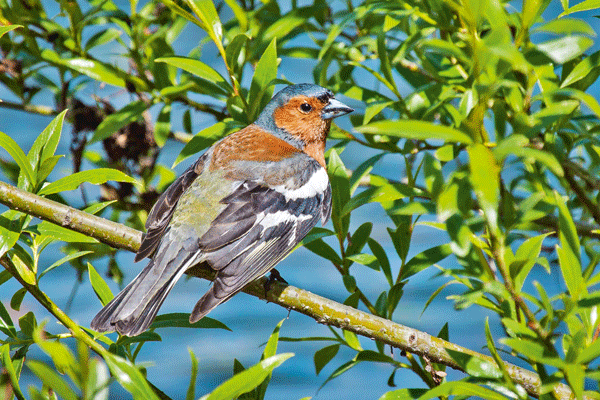
Behaviour: The chaffinch is the most common and most widespread of New Zealand’s introduced finches. During wildlife and bird photography forays, my observations are of a fairly shy, aloof bird that prefers to avoid the fierce competition that other backyard birds like the sparrow get involved in. That said, outside the breeding season, chaffinches will often ‘mob up’ and live together in small flocks, sometimes pairing up with other species of finches and occasionally with others like fantails or silvereyes.
The male chaffinch has to work to get his girl. He becomes very territorial establishing his ‘patch’ in late July to early August and then sings his heart out. Females will visit his home turf and when she eventually likes what she sees and hears, will form a pair bond with the resident male. Unfortunately, he isn’t always rewarded with fidelity and loyalty after his hard work as the female may leave the territory during nest-building and mate with other males in territories nearby.
How to encourage chaffinch: Seeds, seeds and more seeds. This is probably the key to attracting these relatively shy birds. Leave an area to go to ‘fallow’ in your garden which will feed chaffinch and many other species of birds. One of their favourite foods is sunflower seeds. They will take seeds scattered on the ground and pluck seeds from the flowers themselves. Next time you’re thinking about putting some colour into your property, perhaps consider planting some vibrant sunflowers for the chafffinches.
Love this story? Subscribe now!
READ MORE
 This article first appeared in NZ Lifestyle Block Magazine.
This article first appeared in NZ Lifestyle Block Magazine.

